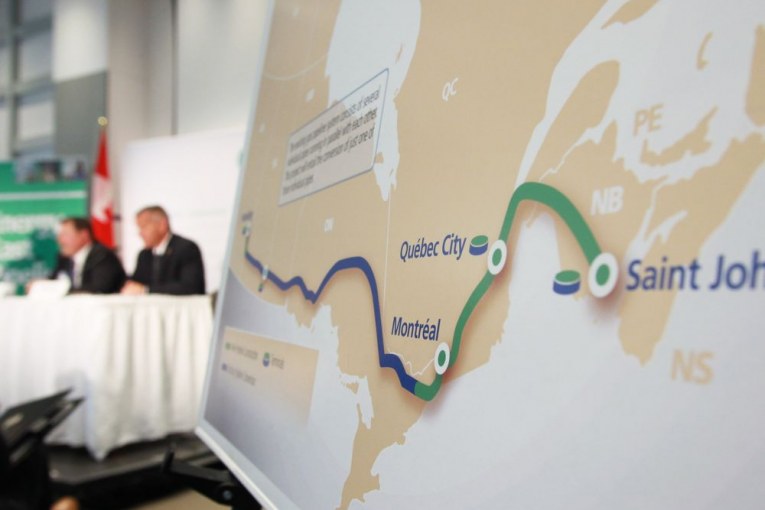
There are so many moments when the deepening wounds for the Energy East pipeline project began to turn fatal.
But what really killed the ambitious $15.7-billion plan by TransCanada Corp. to build a 4,500-kilometre pipeline that could ship oil from Alberta and Saskatchewan all the way to the East Coast?
Was it a precipitous drop in oil prices creating uncertainty for future production?
Or the opposition of Montreal Mayor Denis Coderre — who claimed an “enormous victory” on Thursday — along with municipal and First Nations leaders in Quebec who vowed to derail the venture over environmental concerns?
Was it the collapse of National Energy Board hearings in August 2016, leading to deepening questions about the process in the months ahead?
Was it the decision by the new Trump administration to grant a presidential permit to the once-dead Keystone XL line that would move more Canadian oil to the U.S. Gulf Coast?
Or was it the new NEB panel and its decision two months ago to consider the project’s upstream and downstream greenhouse gas emissions, putting another barrier in place?
The answer is yes to all of the above, with the death knell finally delivered by the recent NEB panel move.
In a brief statement, the company said Thursday after “careful review of changed circumstances,” it wouldn’t proceed with the development. It expects to take an estimated $1-billion after-tax charge in the fourth quarter.
Last month, TransCanada signalled there was trouble ahead when it requested a 30-day suspension of the NEB process, saying it needed time to study the panel’s changes so it could understand how they impacted the project’s cost, schedule “and viability.”
Regardless of where the blame lands — and there’s plenty to go around — the reality is the company pulled the plug on a development that would have helped diversify the customer base for Canada’s single-biggest energy resource.
“It’s the drip, drip, drip of regulatory uncertainty that has brought this to where we are at right now,” said Chris Bloomer, president of the Canadian Energy Pipeline Association.
Make no mistake, that sentiment prevails throughout the energy sector and it will have ramifications for the industry, province and entire country.
The end of Energy East means one less option to move Canadian oil to new export markets.
At some point, analysts warn there could be too much oil produced in the country to get into the existing pipeline system, forcing more crude to move by rail.
It will mean eastern refiners will continue to use oil from countries such as Nigeria, Venezuela and Saudi Arabia. Canada imported more than 750,000 barrels a day last year.
It means lower netbacks for producers, lower royalties and less tax revenue for governments, and fewer jobs for Canadians.
Coming on the heels of the demise of the Aurora and Petronas LNG projects, the retreat of foreign players from the oilsands, weak commodity prices, reduced capital spending and the rejection of the Northern Gateway line, it’s another shot to Alberta’s energy sector.
And in a carbon-constrained world, it begs the question whether any new energy developments can be built in the years ahead.
What it will do, however, is make Canada more dependent on U.S. customers. It also means more uncertainty for future investment.
“What we’re seeing is in the last few months, a bit of a theme of large energy projects — multibillion-dollar projects which would have decades and decades of benefits to Canada — coming out, one after the other, saying we can’t move this project forward in Canada,” said Tim McMillan, head of the Canadian Association of Petroleum Producers.
“When the first ‘no’ came along, everyone said that this is a wake-up call. When the second one came, it was another wake-up call. I think it reaffirms this is a time for action.”
Some have argued the resurrection of Keystone XL south of the border meant Energy East wasn’t needed by shippers — or, at least not as quickly as first thought.
With Canadian oil production expected to grow in the next decade, it’s likely all of the various pipelines being advanced will be required at some point, “it’s just a question of timing,” said analyst Kevin Birn with energy consultancy IHS Markit, noting the importance of future oil prices on that outlook.
There’s no firm assurance around the timing of Keystone XL, the expansion of the Trans Mountain project to the West Coast — which was approved by Ottawa, but is now before a legal review — or Enbridge’s Line 3 project.
“Each of these projects continues to face some challenges,” Birn added. “The question is how much development and how much investment do Canadians want in the upstream sector?”
The company wasn’t talking Thursday, but former TransCanada executive vice-president Dennis McConaghy believes the recent NEB panel decision was “the last straw on the camel’s back” for the firm and its board.
“You can’t have a regulatory process be this dysfunctional where an applicant could spend $1 billion and not even start hearings,” he said.
And so Canada’s energy industry is left with another disappointment, another lost opportunity, and another round of hand-wringing about what could have been.
The blame game, however, has only begun.
Chris Varcoe is a Calgary Herald columnist.
You can read more of the news on source
